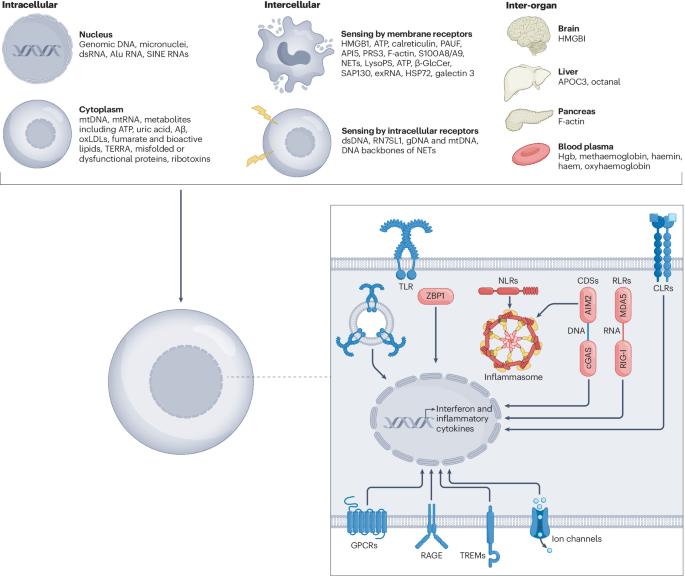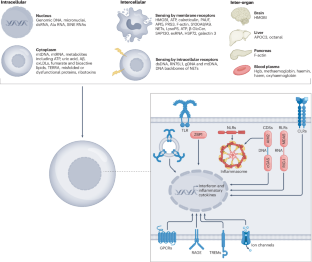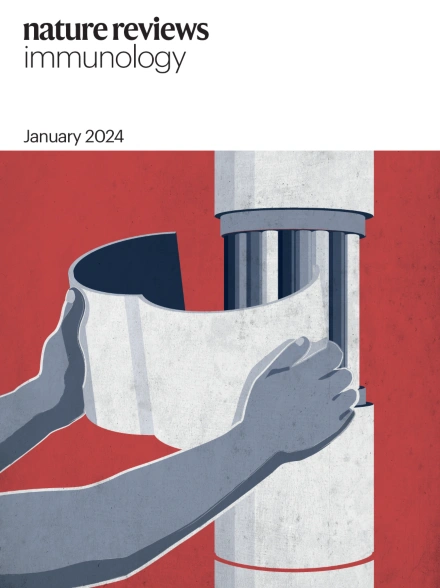DAMP 传感和无菌性炎症:细胞内、细胞间和器官间途径
IF 67.7
1区 医学
Q1 IMMUNOLOGY
引用次数: 0
摘要
损伤相关分子模式(DAMPs)是由于细胞死亡或损伤而从宿主细胞中释放出来的内源性分子。组织中 DAMP 的释放与组织失去平衡有关。先天性免疫受体对 DAMPs 的感知会引发炎症,这可能有利于启动恢复组织平衡的过程,但也可能导致炎症性疾病。近年来,细胞内 DAMPs 的感应在无菌性炎症领域受到广泛关注。然而,新的研究表明,源自邻近细胞甚至远端组织或器官的 DAMPs 也会介导无菌炎症反应。这种多层次的 DAMPs 传感对于细胞间、跨组织和跨器官的交流至关重要。在此,我们总结了 DAMP 感知受体如何检测来自细胞内、细胞间或远端组织和器官的 DAMP,从而介导无菌炎症反应。我们还讨论了针对 DAMP 或其相应受体治疗炎症性疾病的可能性。本文章由计算机程序翻译,如有差异,请以英文原文为准。



DAMP sensing and sterile inflammation: intracellular, intercellular and inter-organ pathways
Damage-associated molecular patterns (DAMPs) are endogenous molecules that are released from host cells as a result of cell death or damage. The release of DAMPs in tissues is associated with loss of tissue homeostasis. Sensing of DAMPs by innate immune receptors triggers inflammation, which can be beneficial in initiating the processes that restore tissue homeostasis but can also drive inflammatory diseases. In recent years, the sensing of intracellular DAMPs has received extensive attention in the field of sterile inflammation. However, emerging studies have shown that DAMPs that originate from neighbouring cells, and even from distal tissues or organs, also mediate sterile inflammatory responses. This multi-level sensing of DAMPs is crucial for intercellular, trans-tissue and trans-organ communication. Here, we summarize how DAMP-sensing receptors detect DAMPs from intracellular, intercellular or distal tissue and organ sources to mediate sterile inflammation. We also discuss the possibility of targeting DAMPs or their corresponding receptors to treat inflammatory diseases. Here, Rongbin Zhou and colleagues review the different types of damage-associated molecular pattern (DAMP) that trigger sterile inflammation via pattern recognition receptors. The authors group these DAMPs on the basis of whether they arise from inside cells, from neighbouring cells or from distant tissues, and they discuss the relevance of such DAMPs in various inflammatory disease settings.
求助全文
通过发布文献求助,成功后即可免费获取论文全文。
去求助
来源期刊

Nature Reviews Immunology
医学-免疫学
CiteScore
93.40
自引率
0.40%
发文量
131
审稿时长
6-12 weeks
期刊介绍:
Nature Reviews Immunology is a journal that provides comprehensive coverage of all areas of immunology, including fundamental mechanisms and applied aspects. It has two international standard serial numbers (ISSN): 1474-1733 for print and 1474-1741 for online. In addition to review articles, the journal also features recent developments and new primary papers in the field, as well as reflections on influential people, papers, and events in the development of immunology. The subjects covered by Nature Reviews Immunology include allergy and asthma, autoimmunity, antigen processing and presentation, apoptosis and cell death, chemokines and chemokine receptors, cytokines and cytokine receptors, development and function of cells of the immune system, haematopoiesis, infection and immunity, immunotherapy, innate immunity, mucosal immunology and the microbiota, regulation of the immune response, signalling in the immune system, transplantation, tumour immunology and immunotherapy, and vaccine development.
 求助内容:
求助内容: 应助结果提醒方式:
应助结果提醒方式:


